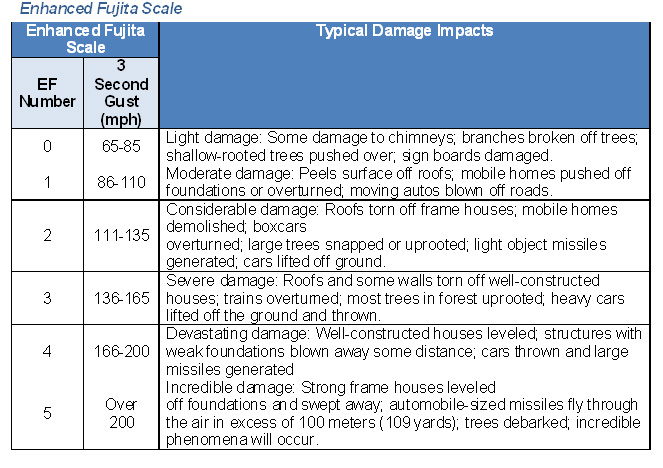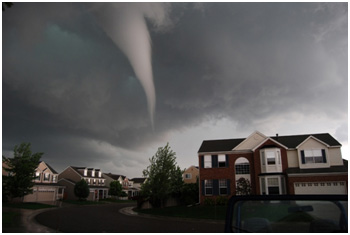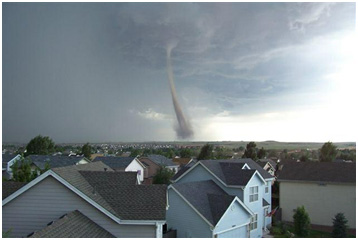
A tornado is a violently rotating column of air extending from a thunderstorm to the ground. The width of a tornado is generally less than half of a mile, but the length of the destruction path can be from a few hundred yards to dozens of miles. A tornado can also move at speeds of 30 to 125 mph, generating winds exceeding 300 mph.
- Tornado Watch - Tornadoes are possible. Remain alert for approaching storms. Watch the sky and stay tuned to NOAA Weather Radio, commercial radio or television for information.
- Tornado Warning - A tornado has been sighted or indicated by weather radar. Take shelter immediately.
Adams County Facts
In Adams County the risk for tornadoes is high. In the Colorado Front Range, tornadoes have been reported in nine months of the year, with the peak season for tornados in Adams County extending from mid-May through mid-August. June is by far the month with the most recorded tornadoes. Tornadoes have occurred at every time of the day, but over half of them have developed between 3 p.m. and 6 p.m. They also occur statewide, but by far the greatest number develops in eastern Colorado east of I-25. Since 1950, the two counties in the state with the most tornadoes have been Weld and Adams (NCDC).
The NWS advises that tornadoes strike randomly, so all areas within the county are at risk, but development in east Adams County will be particularly more vulnerable to tornadoes, as most of the tornadoes recorded have occurred further away from the foothills. Tornadoes will continue to occur in our County; predicting the location and how severe the event is impossible but this fact stresses the importance of taking steps to prepare yourself and your family today.
Hazards and Concerns
In the United States, tornadoes are classified by the Fujita Scale, which assigns numeric scores from zero to five (or higher) based on the severity of observed damages. Tornadoes can cause significant damage to structures, trees, utilities, and crops, and they have the potential to injure and kill people. With advance warning, people can evacuate to safe-rooms, basements, inner-most rooms or other more structurally sound areas within the building. But warning systems are not fool-proof and should be considered secondary to personal preparedness and rational action to protect ones’ own safety. Mobile home parks are extremely vulnerable; even if the mobile homes are anchored down the structures provide little protection. Towers and overhead transmission lines are extremely vulnerable which when damaged can further hinder emergency response and recovery efforts.

Tornado Safety Tips
Before: To begin preparing, you should build an emergency kit and make a family communications plan. •Listen to NOAA Weather Radio or to commercial radio or television newscasts for the latest information. In any emergency, always listen to the instructions given by local emergency management officials.
- Pre-identify shelter areas for locations commonly visited.
- Be alert to changing weather conditions and teach children to do the same. Look for approaching storms and the following danger signs: ◦Dark, often greenish sky
- Large hail
- A large, dark, low-lying cloud (particularly if rotating)
- Loud roar, similar to a freight train.
- If you see approaching storms or any of the danger signs, be prepared to take shelter immediately.
During: If you are under a tornado warning, seek shelter immediately! Most injuries associated with high winds are from flying debris, so remember to protect your head.
- If you are in a structure (e.g. residence, building, school, shopping center, etc.):
- ◦Go to a pre-designated shelter area such as a safe room, basement, storm cellar, or the lowest building level. If there is no basement, go to the center of an interior room on the lowest level (closet, interior hallway) away from corners, windows, doors, and outside walls. Put as many walls as possible between you and the outside, and use your arms to protect your head and neck.
- If you are in a high-rise building
- Go to a small interior room or hallway on the lowest floor possible.
- Put on sturdy shoes.
- If you are in a trailer or mobile home:
- Get out immediately!
- Go to the lowest floor of a sturdy, nearby building or a storm shelter.
- Mobile homes, even if tied down, offer little protection from tornadoes.
- If caught outside with no shelter:
- Find a low-lying ditch or irrigation canal and stay a low to the ground
- Or get into a vehicle, buckle your seat belt and try to drive to the closest sturdy shelter.
- If your vehicle is hit by flying debris while you are driving, pull over and park.
- If you can safely get noticeably lower than the level of the roadway, leave your car and lie in that area, covering your head with your hands.
- If there are no low lying areas immediately available, stay in the car with the seat belt on. Put your head down below the windows; cover your head with your hands and a blanket, coat or other cushion if possible.
- Do not get under an overpass or bridge. You are safer in a low, flat location.
- Never try to outrun a tornado in urban or congested areas in a car or truck. Instead, leave the vehicle immediately for safe shelter.
After: A study of injuries after a tornado showed that 50 percent of the tornado-related injuries were suffered during rescue attempts, cleanup and other post-tornado activities. Because tornadoes often damage power lines, gas lines or electrical systems, there is a risk of fire, electrocution or an explosion. Protecting yourself and your family requires promptly treating any injuries suffered during the storm and using extreme care to avoid further hazards.
- Injuries: Check for injuries. Do not attempt to move seriously injured people unless they are in immediate danger of further injury. Get medical assistance immediately.
- If someone has stopped breathing, begin CPR only if you are trained to do so.
- Stop a bleeding injury by applying direct pressure to the wound. Have any puncture wound evaluated by a physician.
- If you are trapped, try to attract attention to your location.
- Check on neighbors and those who may be in need of additional assistance.
To see the full list of disaster preparedness tips for thunderstorms, visit www.ready.gov/tornadoes.
 |
 |
| June 7, 2009 - Aurora, Colorado | June 24, 2008 - Parker, Colorado |




